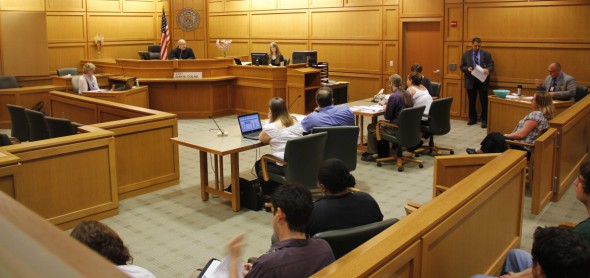Do Drug Courts Discriminate Against Blacks?
Statistics show special courts to help get people avoid prison serve more whites though there are more black offenders.

Dane County Circuit Judge Juan Colas conducts a hearing with advocates of a drug court participant, who is out of the frame. Colas provided access to the court but forbade photography of defendants to protect their privacy. – Taylor Chase/Wisconsin Center for Investigative Journalism
Even before Dane County Circuit Judge Sarah O’Brien crunched the numbers, she knew something was amiss. Her strongest evidence: “The courtroom didn’t look right when I walked in.”
O’Brien, who retired in 2012, was referring to the stark racial disparities in Dane County’s drug court. The people in front of her — the ones who had gotten the chance to reduce or avoid criminal convictions in exchange for completing treatment and other programming — were overwhelmingly white.
In 2012, about one-third of those arrested for drug crimes in Dane County were black, according to the state Office of Justice Assistance. But African-Americans made up just 10 percent of those participating in the county’s drug court that year, according to Journey Mental Health, a Madison nonprofit that provides treatment and case management for the program.
As recently as May, despite a concerted effort to increase minority participation, 84 percent of defendants in Dane County drug court were white and 14 percent were black.
But it is an opportunity many people, particularly minorities, are missing out on in Wisconsin. In Racine County in 2012, for example, 11 percent of drug-court participants were black, although about one-third of all drug defendants arrested that year were African-American. Disparities also can be found in Rock and Milwaukee counties, the Wisconsin Center for Investigative Journalism found.
Experts disagree as to why these disparities exist. Some, including some drug court judges, believe the problem lies in drug use trends.
Studies show African-Americans are more likely to abuse cocaine. Whites are more likely to abuse heroin. Heroin abuse has been described as an “epidemic” and has drawn political attention in part because of the alarming rise in fatal and near-fatal overdoses among its users, who are mostly white.
Other experts say disparities occur not just because of drug choice, but because of a variety of factors outside of drug courts’ control.
One theory is that after years of poor treatment in the criminal-justice system, minorities are less likely to trust any new criminal-justice program. Another is that minorities are more likely to have more extensive criminal histories, which may disqualify them from participation.
Pamela Oliver, an expert on racial disparities in the criminal-justice system, said the reason for disparities in drug courts is a combination of both theories.
“The judicial system treats you worse if you have a previous criminal record, and they don’t apologize for it,” said Oliver, a sociology professor at the University of Wisconsin-Madison.
Dr. Randall Brown, associate professor at the UW-Madison Department of Family Medicine and director of the Center for Addictive Disorders, agreed.
Brown added that some minority defendants with prior criminal histories might consider a few months in jail less onerous than nine months in drug court, a theory also endorsed by Oliver. The cost of drug court is probably not a barrier; in Dane County, offenders have about six to eight months to pay the one-time $50 fee.
Dane County recently underwent a reorganization aimed at making defendants with more serious criminal histories eligible for drug court. A Legislative Council committee also is studying ways to make all of the state’s alternative treatment programs more efficient and cost-effective.
Drug courts gain in popularity
It is a typical day at the Dane County drug court, where Judge Juan Colas meets with defendants who have chosen to try treatment over jail.
One participant, a 27-year-old white Madison woman who asked to not be identified, has two children and an extensive, but nonviolent, criminal history, including driving while intoxicated, forgery, burglary, theft and disorderly conduct — at least some fueled by her addiction to heroin.

Dane County Circuit Court Judge Juan Colas has been the drug court judge since August 2013. Participants can get their criminal charges reduced or dismissed if they finish treatment and other programming. “I genuinely want to see them succeed and have a real empathy for the difficulty of addiction and the complexity of their lives,” Colas says. – Kate Golden / Wisconsin Center for Investigative Journalism
Colas asked her how she was doing. The woman responded, “pretty good,” and ticked off her recent accomplishments: looking for a new apartment, working and staying sober for two weeks. “I feel great,” she said.
“It sounds like things are headed in the right direction for you, and you’re doing what you need to be doing,” the judge responded. “So we’ll see you next week.”
Drug courts were first established in the late 1980s as a way to reduce prison crowding and high recidivism.
In Wisconsin, the interest was fueled by a 2009 report from the state Department of Corrections showing that drug offenders accounted for more than 20 percent of the explosive prison population growth from 1996 to 2006.
There are currently 29 drug courts in Wisconsin, up from five a decade ago.
Michelle Cern, the Wisconsin statewide problem-solving court coordinator, said in the past 10 years, the number of alternative treatment programs of all kinds has doubled.
“Substance abuse touches everyone in some way, shape or form,” Cern said. “Because of the research out there talking about the effectiveness of problem-solving courts, I think there is a greater understanding that the substance abuse issue is not solved solely by incarceration.”
A defendant’s time in drug court usually takes about nine months and is marked with a series of rewards and sanctions depending on a participant’s actions during the program. Those who complete the program are rewarded with either lessened or dismissed criminal charges.
Research shows drug courts work
According to a 2011 study by the UW-Madison’s Brown, offenders who participated in drug treatment courts were 50 percent less likely to commit new crimes; and if they did commit a crime, it was for a lesser offense with an average of 82 fewer days spent in jail.
And a study by the UW Population Health Institute found that in seven alternative treatment programs funded by the state, 2,061 offenders over four years avoided more than 135,000 days of incarceration. These programs were not limited to just drug courts, but included other alternative programs, including one for drunken drivers.
The study also found that offenders who completed one of the treatment alternative programs were nine times less likely to be admitted to a state prison in the future compared to those who did not.
Sanctions and rewards help, but judges said there are other intangible benefits to drug court.
“One of the primary things you need to beat an addiction is hope,” said Milwaukee County drug court Judge Ellen Brostrom. “They (offenders) are not just sober. They’re transformed.”
Colas agreed. “You’re helping people to change by finding out what’s within them motivating them to change.”
He said running Dane County’s drug court is one of the most rewarding things he has done.
“It’s exciting when they graduate because you’ve been with them with their arrests and sanctions and problems with parents and boyfriends and pregnancies,” Colas said.

Dane County Circuit Judge Sarah O’Brien speaks to a graduate of the drug court program before awarding his diploma in this 2005 photo. O’Brien ran the specialty court in Madison until her retirement in 2012. She says participants have been disproportionately white, a disparity the court is attempting to address. – Jaron Berman / The Racine Journal Times
During a recent court session, Colas was protective of the participants, asking that photos not be taken of them to avoid the possibility of derailing their progress.
“You are dealing so intimately with people week after week,” Colas said. “After a long period of months you develop an emotional connection with them that is different.”
But not many minority offenders get to experience that success. Professionals within and outside of the courts say they are not sure why.
Source of disparity unclear
That minorities, particularly African-Americans, are disproportionately incarcerated for drug-related crimes in Dane County is not news. A Justice Policy Institute study found in 2007 that a black resident of Dane County was 97 times more likely to go to jail for a drug crime than a white resident.
“I’m certain there are more white people in the (drug) courts,” Colas said. “It’s hard to say exactly why.”
Brown said tracing the causes is complicated because there are so many places in the system and society in which disparities can occur. When it comes to why whites participate in drug court more often than blacks, he said he has not “fully wrapped my head around the issue.”
“And anyone who says they know what the exact problem is,” Brown said, “is crazy.”
Wisconsin’s disparities are not unique, said Douglas Marlowe, chief of science, policy and law at the National Association of Drug Court Treatment Professionals.
“The entire criminal justice system in every state, county and the federal system has some evidence of disparities, from arrest rates through prisoner reentry,” Marlowe said.
Regardless of when and why disparities occur, Brown said, researchers and policymakers must look “upstream” to address the problem, which stems from unemployment, poverty, lack of education and other factors.
“It’s unfortunate we are relying on the criminal justice system to solve this problem, because it runs so much deeper than that,” he said.
Despite funding boost, resources still scarce
Wisconsin began supporting drug courts in 2005 through a program called Treatment Alternatives and Diversion, also known as TAD. Since then, so-called problem-solving courts in 37 counties have received about $4 million from the state.
Cern said although TAD funding has increased fourfold in the last two years, there is still not enough money to meet the demand. That leaves counties to pick up the increased costs, either through taxpayer funds or federal grants, she said.
A recent study showed the best way to reduce the cost of the criminal justice system is to invest more in TAD programs. The UW-Madison study found that for every $1 the state spends on TAD programs, there is a net benefit of $1.96.
Two drug court judges, Colas and Brostrom, also said county district attorneys’ offices are underfunded and may not be able to meet the demand of working with treatment courts.
“We set up this specialty court, and we’re asking the DA to provide an assistant DA to commit and review reports and preparation. It’s a significant commitment of time,” Colas said. “…the state simply has not provided the funding it should.”
Judges see the problem, react
Some judges, including those in Dane County, have taken steps to get more high-risk offenders into drug court. The theory is that more African-Americans, who are more likely to be high-risk offenders, will gain access to the program.
The Madison-based court previously relied on the district attorney’s office to decide who should be admitted to drug court. As a result, individuals at lower risk to commit new crimes were the ones gaining admission into drug court.
The Dane County reorganization, which began in 2013 and was fully implemented in January of this year, now separates the drug court program into three risk levels based on a series of assessments and does not always require a recommendation from the district attorney.
“The purpose was to broaden access and give the most effective intervention” depending on the individual, Colas said.
Although it is too early to know if the reorganization is working, studies suggest it should.
Research by Marlowe of the National Association of Drug Court Professionals shows that “drug courts can potentially double their effectiveness and cost-effectiveness by focusing their efforts on this high-risk, high-need target population.”
Marlowe said he endorses Dane County’s efforts.
“I am a huge advocate of developing separate tracks based on risk and need,” Marlowe said. “If participants receive services appropriately matched to their needs, this is very likely to reduce disproportionate impacts on minorities resulting from a one-size-fits-all approach.”
Wanted: More research
Despite the successes, just 66 percent of drug court participants graduated between 1996 and 2011 in Dane County, Colas said. Milwaukee County’s Brostrom said the problem is lack of funding to evaluate and offer the most effective programming.
“Our graduation rate would be better if we had better access to high quality, curriculum-based, evidence-based treatment in the community,” Brostrom said. “The need far surpasses the resources.”
O’Brien said the desire for more evidence-based practice is spreading throughout the judicial system.
“We don’t do what our grandfathers did as a judge, we look at the evidence to see what works,” she said. “I don’t think you can replace judges with computers, but judges are learning they need to pay attention to these principles supported by science.”
Policymakers have heard the judges’ calls for better practices. Some answers could come later this year after the legislative committee makes its recommendations on improving problem-solving courts.
The bipartisan committee is led by chairman Rep. Garey Bies, R-Sister Bay, and vice chairman Rep. Evan Goyke, D-Milwaukee. The other 14 members include politicians, judges and treatment experts. The strong bipartisan support for alternatives to incarceration signals a shift from tough-on-crime policies that prompted an explosion in Wisconsin’s prison population.
Among the many suggestions is altering some requirements of TAD grants. Currently courts receiving state TAD money cannot accept people with violent criminal histories. That language has prevented many defendants, particularly minorities, from participating in the treatment courts, Colas said.
The judge added that many offenders can turn their lives around with the help of drug court.
“They are real human beings with real challenges and real potential,” Colas said. “And we always have to keep that in mind, I think.”
The Center collaborates with Wisconsin Public Radio, Wisconsin Public Television, other news media and the UW-Madison School of Journalism and Mass Communication. All works created, published, posted or disseminated by the Center do not necessarily reflect the views or opinions of UW-Madison or any of its affiliates.
-
Wisconsin Lacks Clear System for Tracking Police Caught Lying
 May 9th, 2024 by Jacob Resneck
May 9th, 2024 by Jacob Resneck
-
Voters With Disabilities Demand Electronic Voting Option
 Apr 18th, 2024 by Alexander Shur
Apr 18th, 2024 by Alexander Shur
-
Few SNAP Recipients Reimbursed for Spoiled Food
 Apr 9th, 2024 by Addie Costello
Apr 9th, 2024 by Addie Costello






















The sooner we end the war on drugs the better. It has caused far, far more harm than any drug ever has.
Tyrell, that’s a fine statement as long as you make a concerted effort to forget about the victims of people who commit crimes due to drug issues. Violent assaults, gang wars, strong arm thefts and robberies, and many other drug related crimes are not victim-less, as many would like us to believe. Even “non violent” crimes like breaking and entering can shatter an innocent persons sense of security and cause them harm.
No one said stop policing, just stop wasting taxpayer money & police time on marijuana prohibition. The police should be spending their time on actual crime, like all Andy listed, instead of worrying if Rob & Joe will get the munchies.
Did you ever think that the profits from selling drugs are what lead many into gangs?
Andy, the majority of people in federal prison for drug offenses are in for petty crimes like marijuana possession, and not for committing a violent felony due to drug issues.
I don’t believe there was an explanation of why the drug used-cocaine or heroin- makes a difference in participation.
Thanks
PMD, Do you know where we can find stats on non-violent drug offenses that breaks down the severity of the crimes? There is a difference between possession with intent to distribute vs just possession. Further, what are the stats for people locked up for other non-violent offenses like concealed firearm w/o permit, theft, etc that are not violent but show a history of criminal behavior?
A cousin-in-law of mine has multiple offenses for distribution, traffic violations, burglary, and more… I know he’s also taken part in various violence related crimes for which he was never caught or at least charged. Yet by your measures, he’s a non-violent criminal that’s just being put down by the man. How many of these people you use as statistics fall into that same category?
Your puerile quips are always appreciated Andy. Anyway, is he in federal prison? Why do you think I’d label him a non-violent offender? Because he’s in federal prison simply for marijuana possession?
Here are some stats:
“Contrary to popular belief, the goal of this war is not to root out violent offenders or drug kingpins. In 2005, for example, four out of five drug arrests were for possession, while only one out five were for sales. A 2007 report from Sentencing Project found that most people in state prison for drug offenses had no history of violence or significant selling activity. Nearly 80 percent of the increase in drug arrests in the 1990s, when the drug war peaked, could be attributed to possession of marijuana.”
PMD, let me help you with some of my questions… These are old numbers, do you have anything newer to discredit this?
Inmates in state prison for marijuana offenses (1997)
Drug possession offenses . . . . . . . . . . . . . . . . . . . . . . . . . . . . . . .5.6% of all state inmates
Firsttime drug offenders . . . . . . . . . . . . . . . . . . . . . . . . . . . . . . . .3.6% of all state inmates
Offenses involving marijuana . . . . . . . . . . . . . . . . . . . . . . . . . . .2.7% of all state inmates
Prisoners held for marijuana only . . . . . . . . . . . . . . . . . . . . . . . .1.6% of all state inmates
Prisoners held for marijuana possession only . . . . . . . . . . . . .0.7% of all state inmates
Firsttime offenders held only for marijuana possession
(any amount) . . . . . . . . . . . . . . . . . . . . . . . . . . . . . . . . . . . . . . . . . . .0.3% of all state inmates
This doesn’t even address the whole question regarding other criminal history. You can stop pretending that the poor innocent pot smoker is filling up our prisons.
I never said the poor innocent pot smoker is filling up our prisons. I said that too many people, especially black males, are going to prison for non-violent drug offenses, like marijuana possession. Saying that most people in prison for drug offenses are in for a non-violent offense is not the same as saying that prisons are full of pot smokers. I assume you can see the difference there.
As for more recent stats, according to the Sentencing Project, as of 2012, 50% of the people in federal prison are there for a drug conviction, and the majority have no prior criminal record for a violent offense. I’d say that’s a lot of non-violent drug offenders in a federal prison. At the state level, 16.8% are in for a drug conviction.
http://sentencingproject.org/doc/publications/inc_Trends_in_Corrections_Fact_sheet.pdf
PMD, they left some info off of that… Like of those drug offenders in federal prison, over 90% were for trafficking.
I don’t have time to research what that number is for state prisons, but from a very quick check the part about marijuana drug offenses being the only crime for state prisoners is still less than 2% and possession only is less than 1%. The people you talk about almost always have other offenses or are back in jail for violating parole/probation by having drugs.
Quite frankly, this isn’t an enforcement problem costing too much… this is a problem of people feeling like they can break the law and I and every other tax payer has to foot the bill for their attitude. People who want to use marijuana, of any race, have two choices… move to state that has legalized it or try to change the laws. In the meantime, I have little sympathy for anyone who openly decides to break the law… and that is regardless of their race, income, sex, whatever.
I still say we’re putting too many people in prison for drug offenses, but let’s shift gears. Let’s say they all deserve to be there, because they did in fact break the law by using/possessing/selling marijuana. What about the disparities in race? You can’t really deny that one. We are locking up way more black people than white people despite the fact that they use drugs at an equal rate.
More stats:
-Thursday, 12 October 2006
Washington, DC: Nearly one in eight drug prisoners in America are behind bars for marijuana-related offenses, according to data released this week by the US Department of Justice, Bureau of Justice Statistics (BJS).
The BJS study, “Drug Use and Dependence, State and Federal Prisoners, 2004,” reports that 12.7 percent of state inmates and 12.4 percent of federal inmates incarcerated for drug violations are serving time for marijuana offenses. Combining these percentages with separate US Department of Justice (DOJ) statistics on the total number of state and federal drug prisoners (BJS October 2005 Bulletin: “Prisoners in 2004” — NCJ 210677) suggests that there are now approximately 33,655 state inmates and 10,785 federal inmates incarcerated for marijuana offenses.
NORML Executive Director Allen St. Pierre said that the new BJS statistics belie the myth that few if any US prisoners are serving time for marijuana-related offenses. “According to these figures, nearly 45,000 state and federal prisoners are behind bars for having committed some type of cannabis-related offense,” he said. “This means that US taxpayers are currently spending over $1 billion annually to incarcerate Americans for pot.”
Also, in 2012, the Department of Justice noted that 55,000 people were in a state prison for drug possession. That’s not a large percentage in terms of the total number of people in state prison, but I still think it means there are too many people in prison for drug possession.
I’m not disputing how many people are in prison that have convictions for marijuana offenses. I am saying that almost all of them are also there for other reasons.
And please see my earlier comments regarding the racial inequalities.
Gotcha. If a large percentage have no violent offenses in their past, does that mean the other reasons are previous arrests for possession? And if that is the case, is imprisonment the best way to deal with them?